Bali is known to many as a beach destination, but this is not how I would remember it. I wasn’t attracted by the party vibe that the resorts on the west coast were famous for, so I had chosen to go to Sanur, a relatively quiet town on the opposite side of the island. In reality, because the high season had ended, the atmosphere on the west coast was reasonably calm, while in Sanur it was simply boring. Added to that, the tide was very low when I got there, so it was impossible to swim. The sea was so full of algae that it looked like a giant bowl of soup. But it didn’t matter anymore, because what Bali had on offer was far beyond such small inconveniences.
It was around noon when the taxi dropped me off in front of the hotel in Sanur. I was struck by the strong, almost unreal light. To get to the hotel reception, I had to cross a large garden, decorated with statues of local deities, and full of flowering trees spreading a dizzying scent. It was as if I had walked into a dream. I immediately fell in love with those trees, called frangipani, with long leaves and fleshy flowers colored in white, pink, purple or red. Their perfume, intensified by the heavy air humidity, made me think of a nectar of the gods. During my stay in Bali, wherever I went, I picked frangipani flowers from the ground — they were falling down a bit everywhere — to put them in my hair or hold them in my hand for a while, just to stay immersed in that divine scent. Since then, if I were to think of paradise, I couldn’t imagine it without frangipani.

Sanur beach
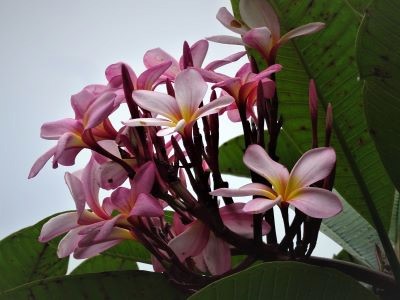
Frangipani
I hadn’t chosen an expensive hotel, so I was amazed to discover my “room”. It was a detached little house with a generous terrace, under a tile roof with curved edges. The window frames were embellished with dense floral motifs in stucco. The interior was no less generous: a four-poster, imperial-size bed in the middle of the room, and massive wooden sculpted furniture along the walls.
When I went out to explore the surroundings, I found more gardens full of flowers, palm trees and frangipani, all endowed with elegant fountains and delicate pavilions. The architecture, even for the most humble dwellings or the smallest temples, seemed to embed genuine works of art: lacy patterns on the window frames, on the doors and even on the roof edges, with carefully chosen natural colors and materials, ample outdoor spaces, impeccably manicured, and majestic wood-carved gates, or even large portals in brick or stone, guarded by statues. With so much beauty incorporated, almost any building was like a small palace.
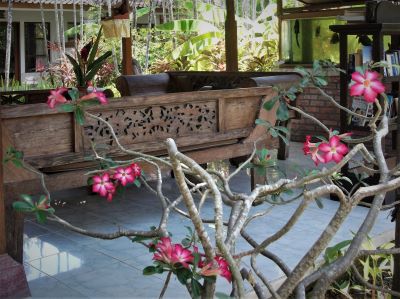
Kiosk
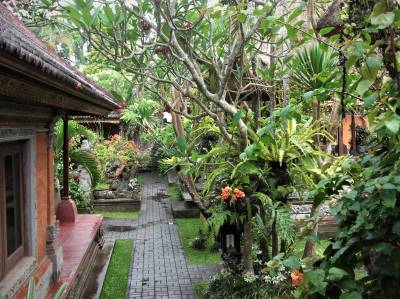
Balinese garden
It was quite common to see, in people’s courtyards, shrines dedicated to various Hindu deities. They were a sort of miniature pavilions, erected on brick pillars, meant to house offerings such as flowers, food, or incense sticks. Little baskets that contained offerings were placed also on the sidewalks, in front of shops or houses. I had to be careful all the time not to step on them. In addition to flowers, some baskets contained colorful cookies, slices of fruits, and even cigarettes, depending on what the gods or ancestors to whom they were dedicated were known to appreciate. Nothing seemed accidental. The offerings were arranged with great care, each element having its meaning and value, just like their strategic placement. Religious beliefs were alive and markedly present in people’s daily lives.
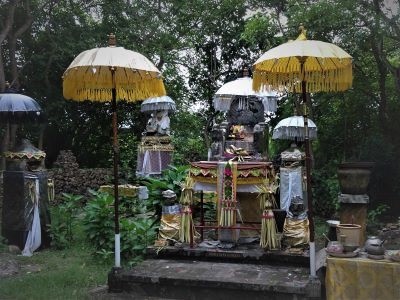
Balinese shrines
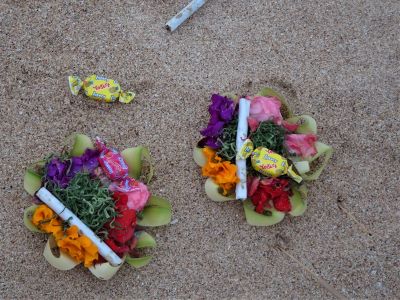
Offering basket
If I were to envisage the notion of “exoticism” pushed to the extreme, entailing a strong amount of strangeness in a natural paradise setting, I could say that I was just being exposed to the highest dose of exoticism that I had ever experienced. The houses, the temples, the fragrances in the air – they weren’t anything familiar. It almost felt like landing on another planet. Not even the sunlight seemed like the one that I knew from home!
At a certain point during my walk, I stopped to gaze at a finely carved door: it had intricate motifs on its entire surface, perfectly contoured in the polished wood. Back home, it would have been worthy of a princess’ chamber. When I looked more closely to see what was written above it, I was amazed to find out that the door belonged to a … hostel. A few enthusiastic young people who came out with their backpacks confirmed to me that it was indeed a place for low-budget, unpretentious tourists. Far from being a luxury, beauty was everywhere, accessible to all.
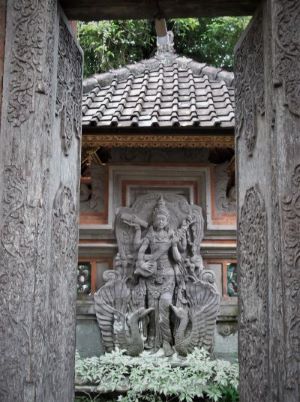
Carved wooden gates
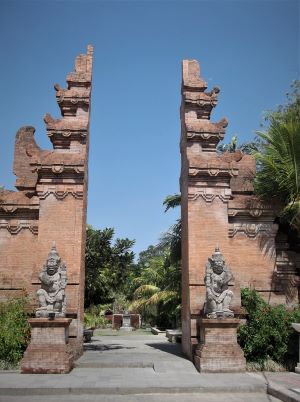
Temple portal
Balinese Hinduism is unique, not only in contrast to the rest of Indonesia, predominantly Muslim, but also compared to the Hindu traditions of other countries. At the end of the 15th century, when Islam was massively spreading in the region, the nobility of the old Majapahit empire, of Hindu faith, together with their relatives and the members of their court, had taken refuge in Bali. For this reason, it was said that the present inhabitants of the island were descendants of either aristocrats, priests, or artists. Not only had Bali sheltered the remnants of the glory of the ancient empire, like a veritable open-air museum, but it had become a thriving home for arts, crafts, and religious rituals, which it had successfully preserved, relatively free from other influences.
The island housed literally thousands of temples. And the temples were unlike anything I had seen before. Moreover, they were often very different from one another, in terms of setting, aspect and atmosphere.
The first one that I visited was Taman Ayun, an odd-looking complex from the 17th-century. All I saw from a distance were several multi-layered roofs, very narrow and high, covered with a sort of dry, long grass — a local plant which, as I was about to find out, was called alang-alang. Those roofs supported by wooden pillars sheltered shrines with relics and statues of deities. Such structures were called meru , and symbolized the sacred mountain with the same name in Hindu mythology, home of the gods and center of the universe. In Taman Ayun, the tallest meru had a roof structured on no less than eleven levels — a number that symbolized royalty.
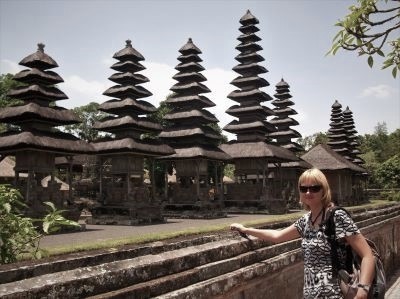
Meru towers in Taman Ayun
In contrast, Tanah Lot was very small, perched on a rock and surrounded by water. Below the rock, there was a cave, where a Hindu priest offered blessings to the devotees and sprinkled holy water. I was surprised to discover that the cave housed a natural spring, a miraculous source of freshwater right in the heart of the sea shore. A few steps away from the spring, I noticed a few snakes with black and white stripes. I was lucky to see them before getting too close, because otherwise, I might have risked an impolite reaction. Those serpents were considered to be the protectors of the temple.

Tanah Lot Temple
At the southwestern tip of the island, after a long climb up a stone alley, I found the Uluwatu Temple. It was right on the edge of a cliff, high above the sea. At sunset, the steep shore hit by foamy waves was turning reddish. The place was full of naughty monkeys, so I was advised to be careful, because they had the bad habit of stealing from tourists everything that caught their attention, such as hats or sunglasses.
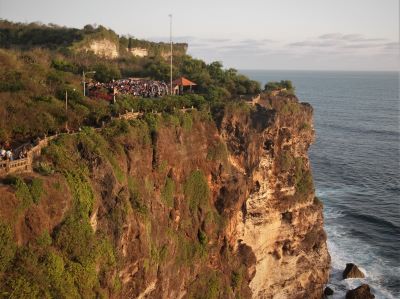
Uluwatu Temple
In the evening, the temple hosted traditional dance and music performances called Kecak. It was a representation of the Ramayana, recounting the adventures of Prince Rama struggling to save his beloved wife Sita from the hands of the demon Ravana, and receiving for that purpose the invaluable help of the monkey god Hanuman. The protagonists of the story, dressed in brightly colored costumes and wearing richly adorned masks or tiaras, were surrounded by a choir of men sitting in a circle around a fire, who were shouting and clapping: chaka-chaka-chaka. It was that unique sound, played at various speeds and intensities, which inspired the name of the dance (pronounced kechak). It was a progressive, hypnotic, trance-like rhythm. In the dark blue night illuminated by sparks of fire, I felt as if I had been being transported directly to the legendary dawn of Hinduism.

Kecak Dance at Uluwatu Temple
The island abounded in banyan trees — a sacred abode of spirits and gods, according to the local beliefs. Their roots descended from the branches, top to bottom, to draw water from the ground, like thick curtains surrounding the tree trunk. They offered shelter on every occasion: a generous shade against the heat and a thick foliage against the pouring rain. Some of them were so large that they looked like genuine temples created by nature, and even housed shrines where the locals brought offerings.
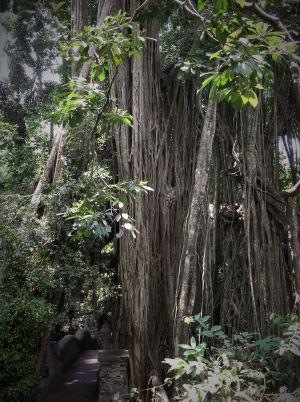
Banyan tree
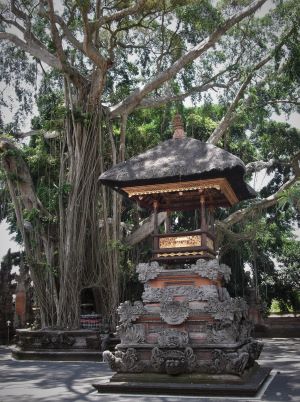
Banyan tree shrine
The Balinese religious practices, apart from their traditional Hindu foundation, contained elements of animism and Buddhism, as well as other customs and beliefs, inherited from time immemorial. Like in classical Hinduism, the Balinese worshiped the trinity of Brahma (creator) — Vishnu (keeper) — Shiva (destroyer), along with many other deities, such as the very popular Ganesha, the elephant-headed god whose statue was present almost everywhere, from people’s courtyards to hotel receptions. In addition, the cult of ancestors played an important role: they had their own shrines where the relatives brought them offerings regularly. Buddhist saints (bodhisattva) were worshiped as well, since Buddhism had spread in Bali through the islands of Java and Sumatra in the first millennium AD.
The diversity of rituals and traditions made the Balinese religion appear very complicated at first sight. I confess that, although I was familiar with Hinduism from books, in Bali I felt quite lost at the beginning. Luckily, I had a good guide — a young graduate from a local university, very enthusiastic and eager for conversation. He was called Agung, like the highest volcano of the island.
“Like you in the West”, Agung started his presentation, “we believe in divine justice that rewards each person based on their actions (karma), in the salvation of the soul (moksa) and in the afterlife — only that the latter, for us, implies reincarnation. We believe that the universe has three layers: the heavenly world of divine entities, the realm of men, and the infernal dwelling of the demons”.
“Moreover”, he continued, “the fact that in Bali we worship so many gods does not mean that we are not able to understand the essence of divinity. In fact, we believe in one God and the immortality of the soul.”
“Yes”, he emphasized, “for us all deities are different manifestations of the same Creator, just like rain, sunshine or forests are different manifestations of nature. We worship each one separately, but that does not mean that we ignore the unique divinity that lies beyond them.”
His simple and conciliatory way of presenting things was irresistibly charming. From such a perspective, many of the customs that I had witnessed, such as offerings for the souls of the ancestors, blessings with holy water, worship of statues and sacred relics … only seemed unfamiliar at first sight. After all, such practices reflected fundamental motivations of the human soul, which are universal. The exoticism was a lot more in the form than in the substance of the phenomenon.
This being said, there were also many striking differences that were pretty hard to digest.
Read Part 2 here.